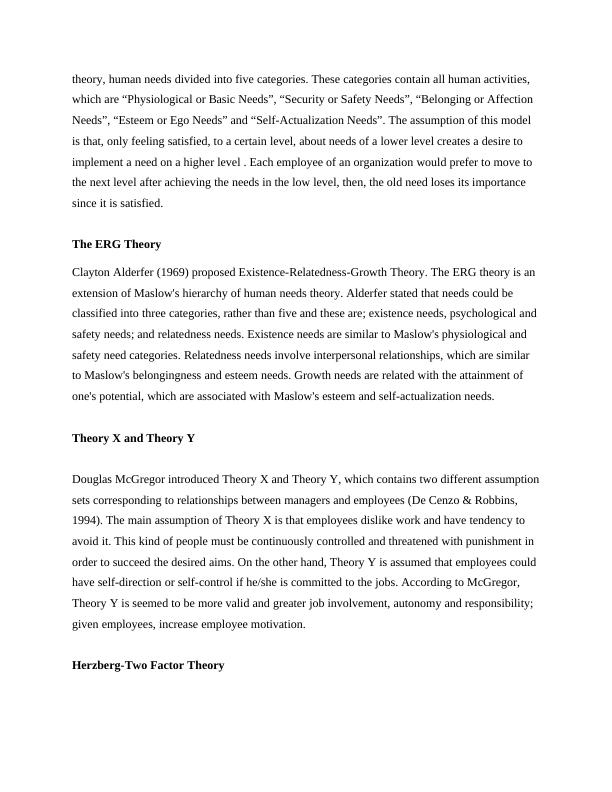Ask a question from expert
Chapter 2: Literature Review- Employees Job Satisfaction
8 Pages2594 Words924 Views
Added on 2019-09-30
Chapter 2: Literature Review- Employees Job Satisfaction
Added on 2019-09-30
BookmarkShareRelated Documents
Chapter 2: Literature Review2.1 Introduction to Employees Job SatisfactionThe notion of job satisfaction is multi-dimensional and may be applicable to productivity and organizational commitment. It is observed as an individual or a social dimension, or from perspectives such as cost and reward, public sector and private sector.The aim of this study is to determine the most important factors that affect the job satisfaction of employees. Job satisfaction is an important indicator of how employees feel about their jobs anda predicator of work behavior such as organizational citizenship, absenteeism and turnover. Job satisfaction is the key element that emphasizes recognition, income, promotion and the achievement of other goals for feeling of fulfillment (AZIRI 2011). Job satisfaction is consideredas an important factor for employees’ retention. It is defined as employees’ views regarding various magnitude of their job (Omidifar 2013). Job satisfaction is explained as a bi-dimensional concept which provides two types of approaches, intrinsic and extrinsic satisfaction dimensions(Funmilola et al. 2013). Job satisfaction is measured by two techniques- Minnesota Satisfaction Questionnaire (MSQ) and Job Description Index (JDI). The MSQ can be utilized both individually and in group but it does not consider gender differences. 1977 version of MSQ indicates various aspects of job like co-workers, achievement, activity, advancement, authority, company policies, compensation, security, working conditions etc. But JDI is one of the widely used measuring technique which

considers all aspects of work, including gender differences. The scale of job satisfaction is a) Nature of work; b) Pay; c) Co-workers and d) Promotion (Astrauskaitė et al. 2011).2.2 Definitions of Employees Job SatisfactionJob satisfaction is defined as “a pleasurable or positive emotional state resulting from the appraisal of one’s job or job experiences”. Locke’s Job Satisfaction Model (1976) is a well-known corner stone theory in the job satisfaction literature. He uses mainly two dimensions for analyzing the job satisfaction: job components and comfort factors. Job components include reward, interest, challenge, autonomy, and relation with co-workers, opportunities to use abilities, creativity, variety, self-esteem, pay, promotion, and supervision. Comfort factors include working hours, travel time, physical surrounding, characteristics of the enterprise and its management, fit between employee, work, and expectations in the workplace. It is also defined by Newstrom (2011) as “a set of favorable or unfavorable feelings and emotions which employees view with their work”. According to Fogarty, job satisfaction is referred to the extent to which employees gain enjoyment from their efforts in their workplace. According to Kaplan (2008), emotional aspect refers one’s feelings regarding the job, cognitive aspect refers one’s thoughts and beliefs regarding the job, and, behavioral component refers to people's actions with respect to the job.Theories of job satisfaction are divided into two categories: content theories and process theories. Content theories identify factors leading to job satisfaction or dissatisfaction and suggest that job satisfaction come true when employees’ need for growth and self-actualization are met by their job. Process theories attempt to describe the interaction between variables for job satisfaction and explain job satisfaction by looking at how well the job meets one’s expectations and values.Maslow’s Hierarchy of Human Needs A.H. Maslow developed the hierarchy of human needs model during 1940-50’s. Maslow’s hierarchy of needs is leading one of the fundamental motivation theories. According to Maslow’s

theory, human needs divided into five categories. These categories contain all human activities, which are “Physiological or Basic Needs”, “Security or Safety Needs”, “Belonging or Affection Needs”, “Esteem or Ego Needs” and “Self-Actualization Needs”. The assumption of this model is that, only feeling satisfied, to a certain level, about needs of a lower level creates a desire to implement a need on a higher level . Each employee of an organization would prefer to move to the next level after achieving the needs in the low level, then, the old need loses its importance since it is satisfied. The ERG Theory Clayton Alderfer (1969) proposed Existence-Relatedness-Growth Theory. The ERG theory is an extension of Maslow's hierarchy of human needs theory. Alderfer stated that needs could be classified into three categories, rather than five and these are; existence needs, psychological and safety needs; and relatedness needs. Existence needs are similar to Maslow's physiological and safety need categories. Relatedness needs involve interpersonal relationships, which are similar to Maslow's belongingness and esteem needs. Growth needs are related with the attainment of one's potential, which are associated with Maslow's esteem and self-actualization needs.Theory X and Theory YDouglas McGregor introduced Theory X and Theory Y, which contains two different assumptionsets corresponding to relationships between managers and employees (De Cenzo & Robbins, 1994). The main assumption of Theory X is that employees dislike work and have tendency to avoid it. This kind of people must be continuously controlled and threatened with punishment in order to succeed the desired aims. On the other hand, Theory Y is assumed that employees could have self-direction or self-control if he/she is committed to the jobs. According to McGregor, Theory Y is seemed to be more valid and greater job involvement, autonomy and responsibility; given employees, increase employee motivation.Herzberg-Two Factor Theory

End of preview
Want to access all the pages? Upload your documents or become a member.
Related Documents
Employee Job Satisfactionlg...
|8
|2512
|265
Factors Affecting Employees Job Satisfaction: A Literature Reviewlg...
|7
|2450
|483
Literature Review- Job Satisfactionlg...
|10
|2551
|250
Factors Affecting Job Satisfaction: A Literature Reviewlg...
|10
|2558
|81
The Effect of Vocational High School Administrators Leadership Behaviors on Teacher Job Satisfactionlg...
|9
|8433
|135
Critique of Human Capital Concept in a People-Centred Workplacelg...
|22
|1507
|247